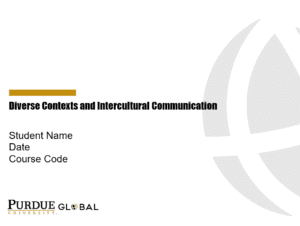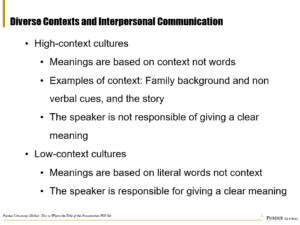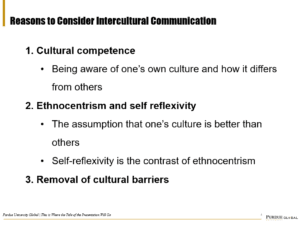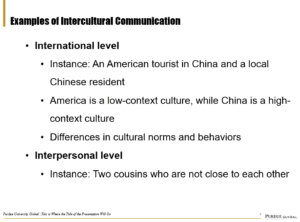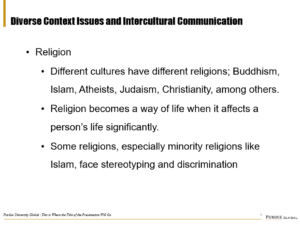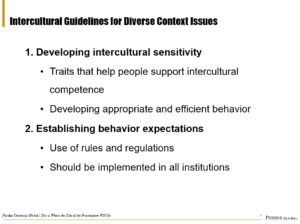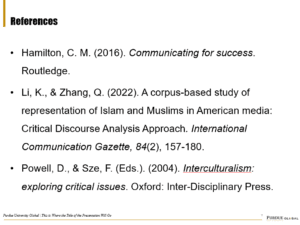Diverse Contexts and Intercultural Communication
Hello and welcome to this presentation on diverse contexts and intercultural communication. This presentation’s objective is to explore intercultural communication and the importance of considering diversity in communication. The various topics covered here will include the impact that diverse context has on intercultural communication. Next, the presentation will delve into the reasons for considering intercultural communication, followed by examples of intercultural communication that should be considered. Further, the presentation will provide a diverse context issue that can be addressed using various intercultural communication strategies. Finally, the presentation will conclude by discussing two intercultural guidelines for addressing diverse context issues.
One of the significant elements that determine the success of intercultural communication is based on Edward Hall’s context theory. Accordingly, Edward Hall developed the context theory, which stated that different cultures tend to have different communication methods, specifically low communication (explicit) or high context communication (implicit). Notably, the context in this instance is used to explain the information surrounding an event. Therefore, people from high-context cultures base their understanding on the communication context and less on spoken words (Hamilton, 2016). Therefore, context plays the biggest role when determining meanings in an interaction. Examples of context include family background, non-verbal cues, and the story behind the situation. In this case, meanings are implied rather than spelled out, leaving the listener responsible for determining the meaning behind some spoken words.
Contrastingly, a person from a low context situation will base their understanding on the literal words spoken rather than the context. Such a person places the responsibility of the meaning behind the words on the speaker. Such diverse contexts then play a role in how intercultural communication occurs because individuals in an interaction will have different expectations of how the communication is carried out and how the messages are encoded and decoded. Without an understanding of these concepts, it is easy for intercultural communication to lead to misunderstandings.
It is worth noting that intercultural communication can be described as sharing information across varying cultures or people from different religions, educational backgrounds, social classes, and ethnicities. The main aim of intercultural communication is understanding the differences in how such individuals live, think, communicate, and their worldviews. Intercultural communication should be considered for various reasons. Firstly, one should consider intercultural communication because it leads to cultural competence. Accordingly, cultural competence describes being aware of one’s cultural beliefs and how these beliefs and values differ from those of others. This ability enables one to understand and interact successfully with individuals from different cultures. Subsequently, being aware of one’s culture puts one in a position to learn more and honor other cultures, which is especially useful in today’s multicultural world. For example, a white nurse from a predominantly white community will have a completely different culture from a Native American. Suppose these two came across each other in a hospital; their cultures and beliefs about medical treatment could crash, leading to conflict. However, with intercultural communication, their interactions would be from a place of understanding and self-awareness, which would help them communicate effectively.
The second reason to consider intercultural communication is ethnocentrism and self-reflexivity. Ethnocentrism is the postulation that one’s cultural perspective is better than or superior to others (Hamilton, 2016). Ethnocentrism convinces a person that what their culture does is normal and right while what other cultures do is abnormal, strange or even taboo. However, through intercultural communication, people learn that their cultural traditions, beliefs and values are just as logical to them as those of different cultures are to the people who follow them. Conversely, self-reflexivity is the opposite of ethnocentrism, which occurs through intercultural communication and can prevent prejudice, discrimination, and stereotyping (Hamilton, 2016).
The third reason to consider intercultural communication is the removal of cultural barriers. The extent of cultural barriers, especially on a global scale, is immeasurable, for example, in personal and professional contexts. Cultural barriers prevent individuals from working together or communicating effectively. Nonetheless, with intercultural communication, there would be a total breakdown of these barriers, which can lead to harmony across all cultures, not to mention the immense benefits that would result from effective interactions.
This section of the presentation will cover two examples of intercultural communications that should be considered. The first example is the international level of communication, specifically between an American tourist in China and a local Chinese resident. Notably, both of these have different contexts, with America being a low-context culture while China is a high-context culture, which is the first difference that will play a part in their communication. Secondly, other cultural norms or behaviors, like eye contact, are viewed differently in both cultures. While Americans prefer eye contact during interactions as it shows respect and focus on the speaker, in China, eye contact is viewed as aggressive and rude. The second example of intercultural communication is interpersonal-level communication. A perfect instance of interpersonal communication is one between two cousins who only get to see each other every five or three years. In such a scenario, the two cousins may share the same culture but have different lives, and one may be a fan of K-pop music while the other prefers Afro music.
This section presents religion as one diverse context issue that can be addressed using intercultural strategies. Notably, different cultures tend to have different religions while others do not: Buddhism, Islam, Atheists, Judaism, and Christianity, among others. As such, religion becomes a culture, especially in cases where it influences how a person dresses, eats, talks, and behaves, among others (Powell & Sze, 2004). Further, religion, as seen with Islam, can lead to stereotyping and discrimination, particularly when juxtaposed against a more dominant religion or culture that has little to no knowledge of such a religion. One major intercultural communication barrier stemming from religion is a person’s lack of knowledge about other religions and their belief systems. However, such problems can be addressed using intercultural strategies.
Two intercultural guidelines can be followed to address religious differences while still demonstrating respect for such differences. One guideline is developing intercultural sensitivity, which is the development of positive emotions for comprehension and exploring cultural or, in this case, religious differences. Accordingly, this guideline highlights the several traits that people need to have to support intercultural competence. Such traits include refraining from judgment or prejudice, being open-minded, having interactive relationships and being empathetic. Further, it requires one to develop appropriate and efficient behavior in defining and evaluating religious differences. Developing intercultural sensitivity today requires one to not rely on information fed to the public by the media because evidence shows that that information is heavily biased and only leads to prejudicial conclusions about targeted communities, for example, the Muslim communities (Li & Zhang, 2022). Interactive relationships, either in person or through online platforms, are a promising way to overcome these challenges and address religious differences. The second guideline to overcoming religious differences is establishing behavior expectations. All institutions, ranging from schools, hospitals and business organizations, should have mandatory rules on appropriate behavior and punishment for inappropriate behavior regarding religious differences or other cultural differences in general. Inappropriate behavior includes demeaning jokes or remarks towards a person’s beliefs, as well as stereotypes. It should be the role of such institutions to ensure that everyone feels safe despite any differences they may have. Such efforts should extend to every corner of society, even in households, to ensure that people grow up accepting of others despite their cultural differences.
ORDER A PLAGIARISM-FREE PAPER HERE
We’ll write everything from scratch
Question
Your employer has asked you to prepare a presentation on intercultural communication and the importance of considering diversity in communication. You must prepare a PowerPoint presentation and create one slide for each of the topics below. Be sure to include your speaker notes in the Notes section below each slide. Include a minimum of two relevant citations throughout your presentation.

Diverse Contexts and Intercultural Communication
Using the Unit 8 Assignment Template, please respond to the following:
Slide 1: Title Slide
Slide 2: Explain how diverse contexts impact intercultural communication.
Slide 3: Provide three reasons to consider intercultural communication.
Slide 4: Identify two examples of intercultural communication that should be considered.
Slide 5: Identify a diverse context issue that can be addressed using intercultural communication strategies.
Slide 6: Provide two intercultural guidelines for how to address the issues identified in Slide 5, while still demonstrating respect for those differences.
Slide 7: References

